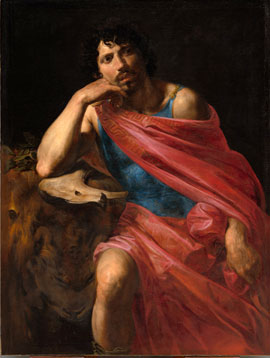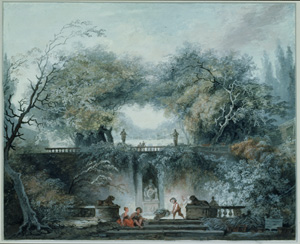Realism in Excess
John Haberin New York City
Valentin de Boulogne: Beyond Caravaggio
Jean Honoré Fragonard: Drawings
What was realism? It makes sense to put the question in the past tense, after Modernism and Postmodernism did so much to put reality into question. Then, too, the past tense may help recover realism for the present. It can do so by showing what one takes for granted as realism as rooted in history.
Realism in art has had many beginnings and many endings, and it is not going away. Some might vote for a breakthrough in the early Renaissance—and a backlash in Mannerism. Some night stick up for realism as one movement among others in the nineteenth century. The Met, though, dares to claim the label for a lesser-known Baroque artist, Valentin de Boulogne.  It makes no such claims for drawings by Jean Honoré Fragonard, but he may well turn out to stick far closer to what lay before his eyes. So what if, often as not, they turn out to be fictions or fantasies?
It makes no such claims for drawings by Jean Honoré Fragonard, but he may well turn out to stick far closer to what lay before his eyes. So what if, often as not, they turn out to be fictions or fantasies?
The saint with a mustache
Who knew that John the Baptist had a pencil mustache? Still in his early twenties, with rakish brown hair and the chiseled body of a young man ready to play, Valentin de Boulogne was painting himself. Not even the saint's traditional red robe altogether covers his earthy brown cloak, not to mention his muscular deltoids and half naked torso. As John, he eyes the viewer while pointing to something beyond the picture frame. John always does, as the prophet of a messiah to come. Is the artist, too, gambling on the future?
For the Met, Valentin was himself that future—and the prophet of a greater realism. His later Allegory of Rome was "the most extreme statement of naturalism" before Gustave Courbet more than two hundred years later. Of course, for a young French painter, arriving in Rome by 1610 or so, the messiah had already come and gone. Some twenty years older, Caravaggio had fled south, amid accusations of murder, after pioneering the Baroque. And where Caravaggio had painted directly from models, rather than from preliminary sketches, for Valentin the model was his most memorable subject, just like his mustachioed presence in place of a legend. The curators, Keith Christiansen and Annick Lemoine, call his retrospective "Beyond Caravaggio."
With forty-five of his sixty surviving paintings, it seeks to reclaim him for a major artist. It begins with other followers of Caravaggio in Rome, including Jusepe de Ribera, a Spaniard who added coarser colors and textures. Ribera, though, departed for Naples, leaving opportunities behind. Valentin found ample commissions and patronage in a powerful cardinal, Francesco Barberini. He also found a pageant of contemporary life, including musicians and gamblers. Even when he painted scenes from the Bible, he sought an array of men, women, and children within a single canvas, as a living theater.
Caravaggio still looms large. Subject after subject comes from him, including those concerts and cardsharps, but also Abraham saved from sacrificing Isaac, Judith slaying Holofernes, and Saint Matthew with an angel's hand in his book. A later version of John approaches Caravaggio all the more closely, with an exposed thigh. Apparently the older man's lifestyle also had its appeal. Born in 1591 just east of Paris, Valentin died at age forty-one after a hard night's drinking. He must have taken his images of all the five senses personally.
Caravaggio may well loom too large by half, and so may Artemisia Gentileschi or another Frenchman in Rome, Nicolas Poussin. Their miraculous sunlight and darkness have become an indistinct space of muddy shadows. Their psychological intensity has become a routine theater. When Caravaggio gives a man bearing grapes recognizable features, the invitation takes on a disturbing eroticism. When his cardsharps vie to see who can outsmart the other, they match wits with the viewer as well. Valentin's figures, however crowded, seem apart from one another, like a catalog of gestures and expressions.
Those gestures include an arm outstretched to the left, which recurs in painting after painting as a token of decisive action. At times Valentin seems to care more about dice in midair or well-worn playing cards than about any of them. He also seems hardly to care where his figures land. They may tumble off the bottom edge or parade above a fictive carved relief as if floating above. The show opens with a photo of Caravaggio's Martyrdom of Saint Matthew, with bodies flying everywhere. Its disorder reflects a revolutionary painter's last struggles with Mannerism—and his successors may have taken that struggle to heart, at the expense of missing the future.
It sounds preposterous anyway to single out an allegory of Italy for its naturalism, quite apart from the Met's penchant for self-congratulation. What are all those aging nudes and cupids doing, and why has Valentin buried his triumphant figure somehow floating above in so much clothing? At his best, the sheer flurry of hands across a canvas can stand in for a deeper insight. So does the edge of a knife on its way to flaying a man alive. So, too, at times does what may seem like Valentin's greatest weakness—his actors lost in a dream, even as the angels and allegories descend. In one last self-portrait, as Samson, he has already slain Goliath and can take stock of the consequences, and so at last can you.
A Rococo realism
Was Jean Honoré Fragonard a realist? He may seem the worst conceivable candidate for that honor. A student of François Boucher, he pushed his teacher's Rococo fantasies to their limits and beyond. He takes to the moral fables of Jean-Baptiste Greuze and the Enlightenment, only to leave them without a moral. On his Island of Love, one can strain to tell the human beings from cherubs, and neither feels the pull of the earth. His nearly two hundred drawings after Orlando Furioso, the epic poem, live in a dream world between an uncertain ground and a restive sky—and scholars still strain to identify the scenes at hand.
 Yet even the sternest realist can admire his drawings at the Met. He studies the fall of light on the density of acanthus leaves and later a chestnut tree, and he executes copies after Jacob van Ruysdael, the Dutch landscape artist. In his twenties, on a trip to Rome, he captures the stairs and waterfalls of parks recognizable as tourist attractions to this day. Over time, he compiles a compendium of country life, from a fisherman at his nets to a communal bread oven. In the city, he is equally attentive to a young Neapolitan woman, children at play, a deacon in profile lost in his book, and a sultan. Recording a trip down the Rhine with friends, he depicts them all as seasick and exhausted.
Yet even the sternest realist can admire his drawings at the Met. He studies the fall of light on the density of acanthus leaves and later a chestnut tree, and he executes copies after Jacob van Ruysdael, the Dutch landscape artist. In his twenties, on a trip to Rome, he captures the stairs and waterfalls of parks recognizable as tourist attractions to this day. Over time, he compiles a compendium of country life, from a fisherman at his nets to a communal bread oven. In the city, he is equally attentive to a young Neapolitan woman, children at play, a deacon in profile lost in his book, and a sultan. Recording a trip down the Rhine with friends, he depicts them all as seasick and exhausted.
Still, he covers them at a fever's pace, and little is as it seems. He cares more for contrasts of light and dark than for plant species, and his trees belong to an enchanted forest, from the Italian poetry of Torquato Tasso. He prefers the artifice of parks to city streets, and anyway he had come to Rome to study at the Académie de France. Scenes of country life mix casually with stock figures from the stage and memories of Italy. A model sat for that sultan, and Fragonard may well have fashioned the sultan's costume out of thin air. In drawing himself in the ship's hold, he stands at a distance impossible in a self-portrait, like the audience for a play.
So what what was realism, and who is to say what is real or imagined? For Fragonard, born in 1732, life blends effortlessly into theater. At the very birth of the Rococo, Jean Antoine Watteau moved between the art of music and a war zone, in search of moments of relief from human weakness. Fragonard prefers the human comedy. A child takes to his pet dog for a riding lesson, lovers fail dismally to hide in a closet, and an "indiscreet bull" butts into a shepherd's amorous pursuits. If anything, the French Revolution had him looking for a recourse further still from the hard facts of life, right up to his death in 1806. No wonder he turned to the chivalry and romance of Orlando Furioso in the 1780s.
The Met is throwing the word naturalism around all too easily these days, as in its show of Valentin de Boulogne. It also returns to Fragonard barely a decade after his drawings at the Morgan Library and restoration of his period room at the Frick. Still, "Drawing Triumphant" supplies a thorough survey of the artist from New York collections alone. It follows him through two trips to Italy and back, the second at age forty-one. The curator, Perrin Stein, also includes prints, many as learning aids. Charmingly, his student responds with a portrait of the "genius" of Benjamin Franklin, just when the Met also exhibits Franklin's years in France on behalf of an emerging nation and the American Revolution.
Fragonard was hardly a revolutionary, although he sent his son to study with Jacques-Louis David. He was, though, a quick study and an even quicker draftsman. Red chalk and washes give his dream visions the immediacy of daily life. A magistrate takes shape from the folds in his robe and lovers from a wood's edge under a stormy sky. Diogenes, the ancient philosopher, and a peasant seem to draw on the very same model. An artist at work in a trellised garden could be his ultimate fantasy—or a stand-in for Fragonard himself.

Valentin de Boulogne ran at The Metropolitan Museum of Art through January 16, 2017, drawings by Jean Honoré Fragonard through January 8. A related review looks at past shows of drawings and a period room by Fragonard.




